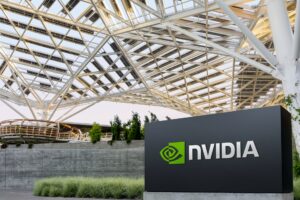It might be years away, but some company will eventually get there.
Nvidia (NVDA -0.08%) stock is soaring again.
The artificial intelligence (AI) chip leader reached a new all-time high on Thursday, fueled by a strong third-quarter earnings report from close partner Taiwan Semiconductor Manufacturing and enthusiasm around its new Blackwell platform, which is reportedly sold out for the next year.
Nvidia CEO Jensen Huang even said recently that demand for the new chips was “insane.”
Taiwan Semi also helped tamp down concerns about an AI bubble as CEO C.C. Wei noted that his company works with almost every AI innovator, and said of AI, “The demand is real, and I believe it’s just the beginning of this demand.” He also predicted, “It will continue for many years.”
Nvidia has thus far claimed most of the spoils in the AI race as the stock has gained close to 10x since the start of 2023, shortly after ChatGPT was launched.
Along the way, Nvidia has added roughly $3 trillion in market cap, and it’s now the second most valuable company in the world behind Apple (AAPL -0.26%). As of Oct. 18, Nvidia’s market cap was $3.39 billion, just shy of Apple at $3.57 trillion. Microsoft isn’t too far behind at $3.11 trillion.

Image source: Getty Images.
Can any company get to a $10 trillion market cap?
It might seem far-fetched to predict the first company to reach $10 trillion, but it’s more likely to happen than it may seem. Apple became the first U.S. company to reach a valuation of $1 trillion, which at one point seemed impossible, in August 2018, and it only took the iPhone maker another five years to reach $3 trillion — becoming the first to pass that milestone as well.
If Apple was able to reach $1 trillion and then triple its valuation in just five years, it might not be as difficult as it might seem for Nvidia or one of its peers to triple in valuation, say within the next five to 10 years, to reach a market cap of $10 trillion.
The contestants in the $10 trillion race
In addition to the three $3 trillion companies, there are also five more stocks with market caps of $1 trillion or more. Those are Alphabet, Amazon, Meta Platforms, Taiwan Semi, and Berkshire Hathaway.
In order for any of these companies to achieve a $10 trillion valuation, they will have to deliver strong growth on the top and bottom lines and likely expand their addressable markets along the way.
Berkshire Hathaway, the only non-tech company on the list, seems unlikely to get there as it mostly operates mature businesses that grow at a pace similar to the overall economy.
The rest of these businesses have faster growth rates, but the ones that are already above $3 trillion are significantly closer to the goal than those valued at around $2 trillion or less.
Why Nvidia is the favorite
Out of Apple, Microsoft, and Nvidia, Nvidia is by far the fastest-growing. The company has reported five straight quarters of triple-digit revenue growth, and while that streak is expected to end in the third quarter, analysts still expect Nvidia’s blistering revenue growth to continue. The consensus calls for Nvidia to report 82% revenue growth in the third quarter and 43% in 2025 to reach $182 billion.
In addition to outgrowing its big tech peers, Nvidia also seems better prepared to capitalize on the next big innovation in technology, much as it has with generative AI and cryptocurrency before that. Nvidia figures to be a winner from emerging technologies like autonomous vehicles and robotics as it’s established a significant competitive advantage in AI GPUs, which will be necessary to power those technologies.
Investors should also be mindful that the innovation that leads to the first $10 trillion company may not even be visible now.
The growth possibilities at Apple and Microsoft seem more constrained. Both companies dominate their respective subsectors, Apple with consumer electronics and Microsoft with enterprise software. But those categories offer less growth. Smartphones are already a mature market. Apple can coax its customers to spend more on iPhones and sell more services and accessory devices like AirPods and Apple Watches, but people generally only need one phone each.
Microsoft’s business is more connected to enterprise tech spending, but again the upside potential is not as large as Nvidia’s. It’s rare for a company to, say, double its software spend in a year.
Will Nvidia hit $10 trillion?
Whether Nvidia is able to grow to a $10 trillion valuation will depend on its ability to fend off competition, capitalize on the AI boom, and maintain, or even expand, its huge profit margins.
Doing that won’t be easy, but it is possible, especially over a horizon of five or 10 years.
Apple’s surge from $1 trillion in 2018 to $3.5 trillion today is a reminder that there’s no strict upper limit on stock market valuations. Even as Nvidia has already delivered monster gains for investors, there’s still more upside potential for the stock.
A $4 trillion market cap isn’t too far away for Nvidia now, and over a longer time frame, $10 trillion is achievable.
John Mackey, former CEO of Whole Foods Market, an Amazon subsidiary, is a member of The Motley Fool’s board of directors. Suzanne Frey, an executive at Alphabet, is a member of The Motley Fool’s board of directors. Randi Zuckerberg, a former director of market development and spokeswoman for Facebook and sister to Meta Platforms CEO Mark Zuckerberg, is a member of The Motley Fool’s board of directors. Jeremy Bowman has positions in Amazon and Meta Platforms. The Motley Fool has positions in and recommends Alphabet, Amazon, Apple, Berkshire Hathaway, Meta Platforms, Microsoft, Nvidia, and Taiwan Semiconductor Manufacturing. The Motley Fool recommends the following options: long January 2026 $395 calls on Microsoft and short January 2026 $405 calls on Microsoft. The Motley Fool has a disclosure policy.







